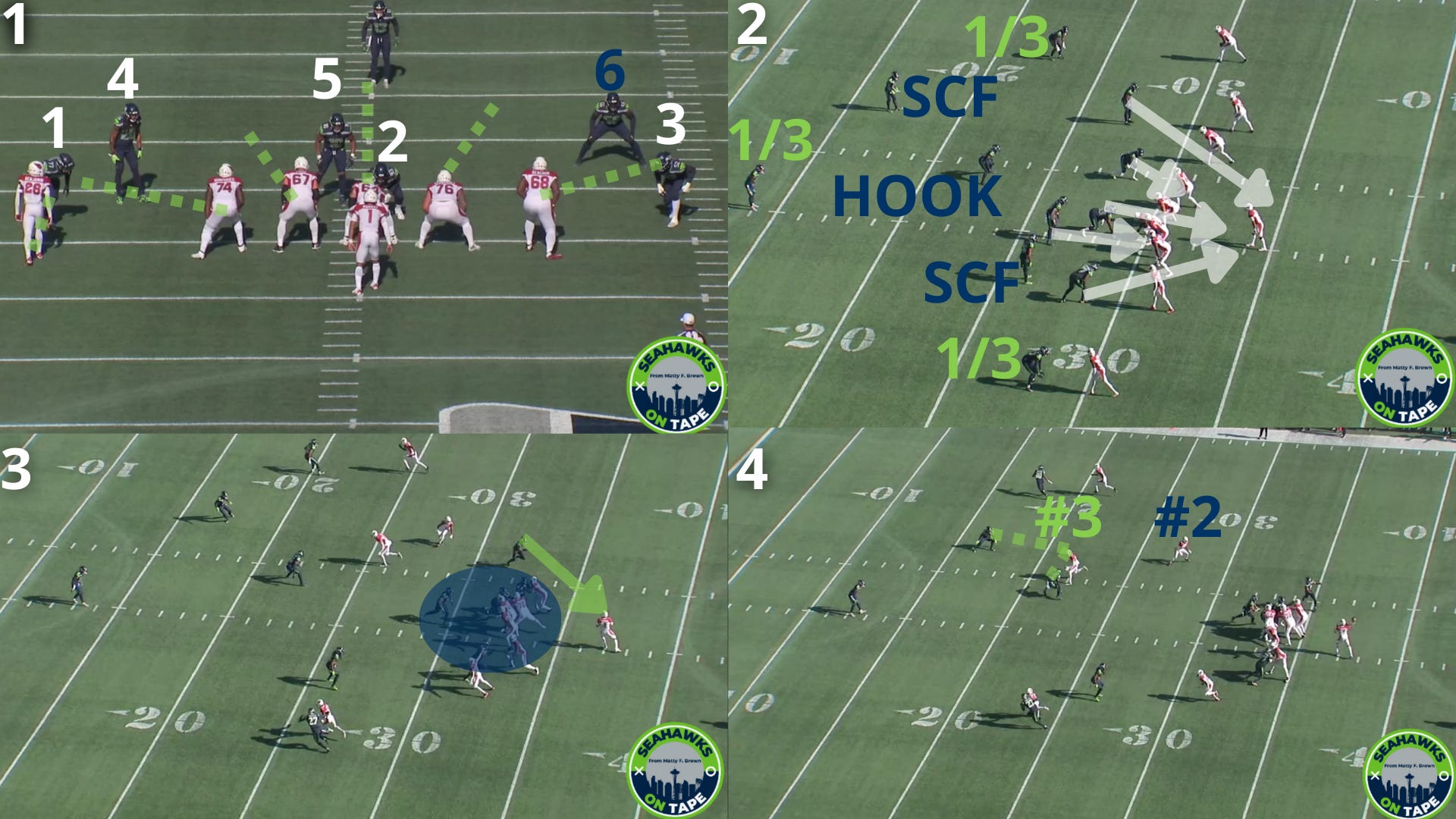Seahawks Bonus Fire Zones
How Seattle's defense is sending second level blitzers, taking the ball away, and playing tight coverage––while rushing just four defenders
Intro
Get excited: The Seattle Seahawks are running bonus fire zones! “Okay Matty, that’s great, but why does that matter beyond some nifty football jargon, ya geek?”
Well, Clint Hurtt’s 2022 defense is able to cover receivers tighter, confuse offenses, and get pressure on quarterbacks all while using just four rushers.
Pressure leads to sacks and takeaways. Indeed, bonus fire zone concepts have already led to 2 pass breakups, 1 interception, 1 sack, 1 tackle for loss, 2 quarterback hits, and 3 third down stops this season.
Seattle has implemented further bonus fire zones from their 2021 campaign, a natural move from new-for-2022 defensive coordinator Hurtt given his past experience with Vic Fangio—a regular user of BFZ.
Fire Zone Issue
To understand bonus fire zones, you must first understand the fire zone.
Rather than a defense sending the stock four rushers at the quarterback and dropping seven into coverage, they add one man to the pass rush and send five.
Behind this pressure, the defense plays zone coverage. However, because they have lost one coverage defender to the rush, they have to play tighter coverage from a spacing and receiver perspective.
The most common fire zone in the NFL is the 3-deep, 3-under structure—the cover 3 edition.
Rather than having four underneath defenders in the classic cover 3 spacing of curl-flat, hook-curl, hook-curl, curl-flat, the defense instead has three underneath.
These players are deployed in more match-like techniques. Fangio’s system calls it “seam-curl-flat, middle hook, seam-curl-flat.” Carroll’s past language has described it as “hot to #2, hot to #3, hot to #2.” The latter version feels more instructive in that these three under players are really looking to cover a specific, numbered receiver.
Seattle’s 2022 fire zones have been a defensive issue.
Here, in this week 6 example versus Arizona, the Seahawks’ odd front on this early 3rd and medium forced big-on-big, man protection from the five Cardinals blockers.
This was the pass pro look needed for the blitzing nickel Coby Bryant to arrive from the slot unblocked at quarterback Kyler Murray. This was set up by the off-ball Uchenna Nwosu looping to Bryant’s side, commanding the attention of the right guard. Simultaneously, Darrell Taylor took an inside jab step off the edge to make the blitz-side tackle step down.
Murray knew he was hot off Bryant and was able to find Rondale Moore’s nestled route for an easy first down conversion.
This process was far too easy because both Jordyn Brooks and Quandre Diggs played the innermost receiver, the #3. Typically, this would be the responsibility of the middle hook defender, Brooks. And Diggs in his seam-curl-flat would play the #2, Moore.
However, pre-snap, (around the 0.08 mark of the video) you can see Diggs pointed out the split of the #3 and #2 receivers to Brooks. It seems Diggs, likely influenced by tendencies, expected Brooks to take the shallower of the two receivers in coverage—a tool Seattle has utilized this season. The coverage mistake prevented any possibility of a sack.
While a seam-curl-flat defender matches up with the #2 receiver and the middle hook takes the #3, the defense can assign a “new #3” and “new #2” to alleviate stress. This is sometimes called a “push”, “switch”, or “fast #3” call. The Seahawks have busted this twice for 2022 touchdowns.
In Santa Clara, the 49ers 2x2 receiving set changed pre-snap with Deebo Samuel motioning across the formation to create a third eligible receiver to the defense’s right: a “fast #3”.
With Seattle blitzing strong safety Josh Jones, linebacker Cody Barton was the seam-curl-flat defender to that side. Rather than matching up with his old #2 receiver, tight end Ross Dwelley, Barton pushed outside to his new #2, Samuel.
That meant that Dwelley, rather than being the new #2, became the new #3 for middle hook linebacker Jordyn Brooks to cover. This was a doable call for Seattle given Dwelley was attached to the formation and placed to the short side.
Yet Brooks took a step clamping down towards Samuel, leaving Dwelley’s sail route towards the sideline wide open for an easy touchdown. Brooks played as though he expected Barton to stay on Dwelley.
Bonus Fire Zones
A bonus fire zone is the defense dropping a defender at the line of scrimmage and sending a less typical defender at the passer, rushing just four in total.
Now four-man pressures do exist in the form of “creepers” and “simulated pressures.” Where bonus fire zones differ is that—unlike creepers and sims, which drop into standard zones—the defense plays the tighter, fire zone coverage behind the rush.
The dropping defensive lineman is assigned a “bonus hook”, where they drop to an area. This is a simultaneously a less-taxing responsibility for a non-traditional coverage defender but also serves to alleviate the stresses that exist in your standard fire zones.
With the defense struggling in Detroit, they called in a bear front bonus fire zone, sending Uchenna Nwosu with Darryl Johnson dropping into the bonus hook.
With a fast #3 scenario similar to the 49ers game, it looked like Brooks had played his new #3 well with Jones expanding to the new #2. However, Brooks came off T.J. Hockenson, seemingly trying to get a head start on the checkdown.
Brooks playing outside of his assignment led to a frustratingly long, highly preventable touchdown.
The Successes
With the basics of the concept explained, it’s now time to show you that bonus fire zones have been a real success overall! No more busts!
I hope you’re not reading this at work! This 3rd and 12 versus the Denver Broncos is certainly not suitable.







